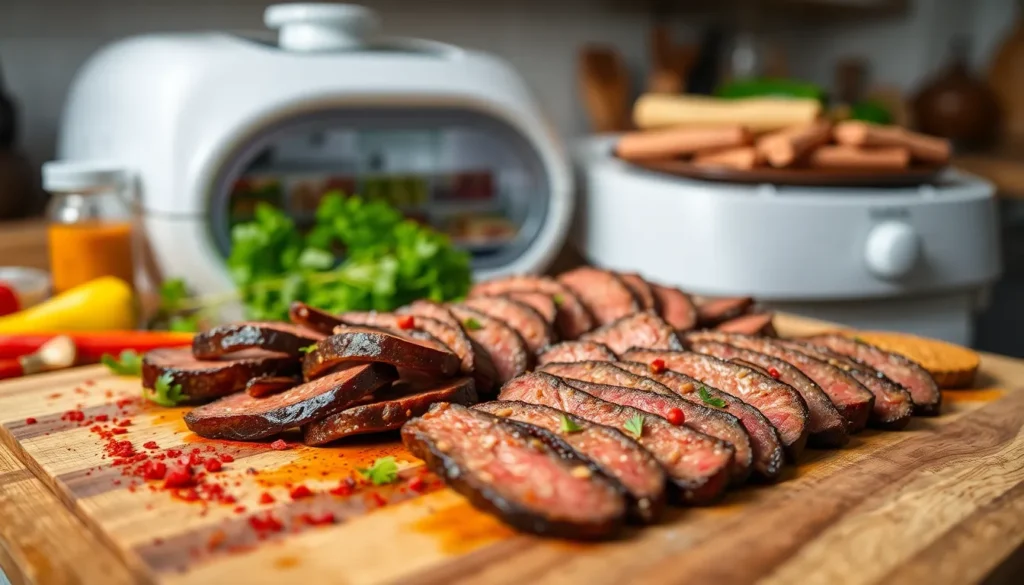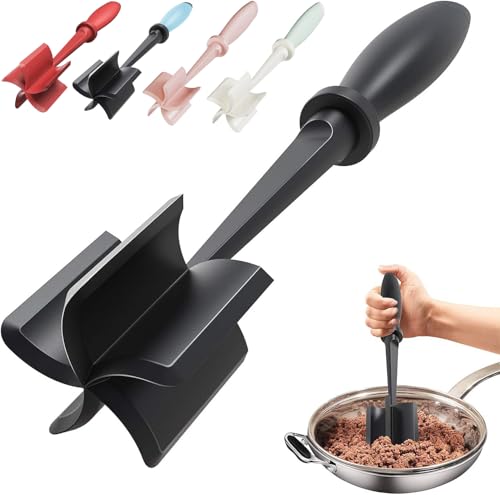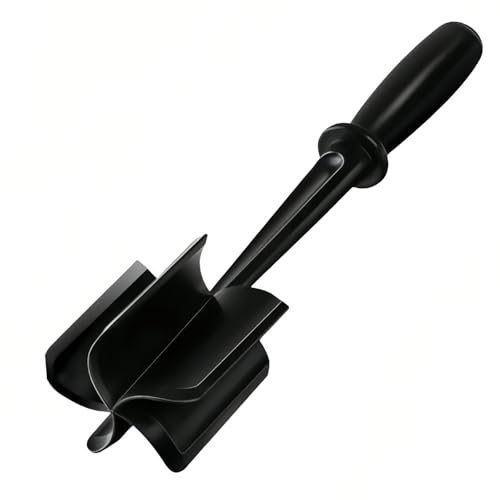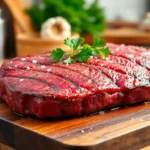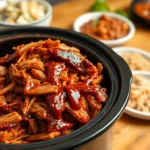We’ve perfected the ultimate teriyaki beef jerky recipe that transforms tough cuts of meat into irresistible chewy snacks bursting with sweet and savory Japanese-inspired flavors. Using a dehydrator makes this process foolproof and delivers consistently perfect results every single time.
There’s something magical about the combination of soy sauce, mirin, and ginger that elevates ordinary beef into an addictive protein-packed treat. Our homemade version beats store-bought jerky hands down – it’s fresher, more flavorful, and doesn’t contain unnecessary preservatives or artificial ingredients.
Making teriyaki beef jerky in a dehydrator isn’t just cost-effective; it’s incredibly satisfying. We’ll show you exactly how to select the right cuts of meat, create the perfect marinade balance, and achieve that ideal chewy texture that keeps you reaching for more. Get ready to impress your family and friends with this restaurant-quality snack made right in your own kitchen.
Equipment Needed
Having the right equipment makes all the difference when creating perfectly textured teriyaki beef jerky. We’ll walk you through the essential tools and dehydrator specifications that ensure consistent results every time.
Dehydrator Requirements
We recommend using a dehydrator with at least 6 trays to accommodate larger batches of beef jerky. The unit should maintain temperatures between 135°F and 165°F for optimal meat dehydration and food safety.
| Dehydrator Specification | Minimum Requirement | Recommended |
|---|---|---|
| Temperature Range | 135°F – 165°F | 120°F – 175°F |
| Number of Trays | 4 trays | 6+ trays |
| Wattage | 400 watts | 600+ watts |
| Timer Function | Manual monitoring | Built-in timer |
Look for models with adjustable temperature controls and built-in timers for hands-off operation. Units with horizontal airflow provide more even drying compared to vertical flow models. We prefer dehydrators with removable trays for easy cleaning after each jerky batch.
Additional Tools
Sharp knives are essential for achieving uniform meat slices that dry evenly. We use a chef’s knife or slicing knife to cut beef strips between 1/8 and 1/4 inch thick.
Glass or plastic bowls work best for marinating the beef without reacting with acidic ingredients. Choose containers large enough to hold all meat pieces while allowing the marinade to coat every surface.
Measuring cups and spoons ensure accurate marinade ratios for consistent flavor profiles. We keep both dry and liquid measuring tools on hand for precise ingredient portions.
Food-safe gloves protect your hands during meat handling and prevent cross-contamination. Disposable nitrile gloves work well for this purpose.
Paper towels help remove excess moisture from meat surfaces before seasoning. We also use them to pat dry the beef after marinating but before placing on dehydrator trays.
Choosing the Right Beef
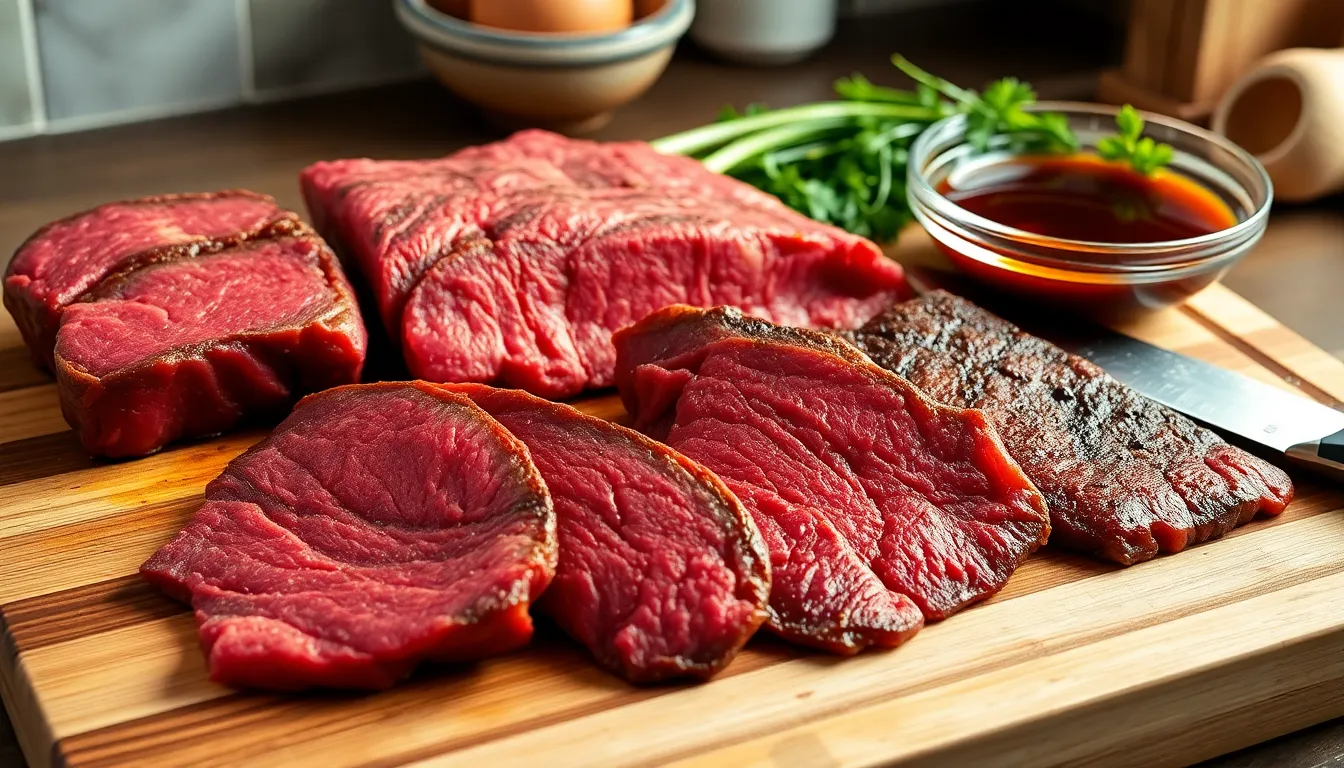
The foundation of exceptional teriyaki beef jerky starts with selecting the proper cut of meat. We need lean cuts with minimal fat content because fat prevents proper dehydration and can cause spoilage during the drying process.
Best Cuts for Jerky
Our top recommendation is top round (also known as London Broil) due to its consistent shape, affordability, and reliable results. Commercial jerky makers frequently choose this cut because it offers the perfect balance of tenderness and flavor while remaining economical for home use.
Eye of round delivers exceptional results with its very lean composition and tender texture. This cut requires minimal trimming and produces uniform jerky strips that dehydrate evenly in your machine.
Bottom round provides excellent value even though being slightly tougher due to connective tissue. The cut originates from the upper outside rear leg and develops rich flavor during the marinating process.
We also recommend sirloin tip as a reliable alternative that butcher shops commonly stock. While less tender than eye of round, it still produces quality jerky when properly prepared and marinated.
Flank steak and skirt steak offer bold flavors and lean profiles that work well for jerky production. These cuts require careful slicing but reward you with intense beefy taste that pairs beautifully with teriyaki marinades.
Lifter and pectoral cuts from the round primal provide additional lean options. These cuts benefit from the frequent movement during the animal’s life, resulting in firm texture and concentrated flavors.
| Cut Type | Characteristics | Best For |
|---|---|---|
| Top Round | Consistent shape, affordable, tender | Beginners and commercial-style results |
| Eye of Round | Very lean, tender, minimal trimming | Premium quality jerky |
| Bottom Round | Tougher but flavorful, economical | Budget-conscious cooks |
| Sirloin Tip | Moderately tender, widely available | Versatile home use |
| Flank/Skirt Steak | Lean, intensely flavored | Bold taste preferences |
Meat Preparation Tips
Start by trimming all visible fat from your chosen cut using a sharp knife. Fat content prevents proper dehydration and creates potential spoilage points that compromise the finished product’s shelf life.
Slice the beef into uniform strips measuring 1/8 to 1/4 inch thick for consistent drying results. We recommend partially freezing the meat for 30 to 60 minutes before slicing to achieve clean, even cuts without tearing the muscle fibers.
Prepare your teriyaki marinade using soy sauce, honey or sugar, fresh garlic, ginger, and complementary seasonings. Marinate the sliced beef for a minimum of 4 to 6 hours, though overnight marination produces superior flavor penetration.
Remove the beef strips from the marinade and pat them completely dry with paper towels. Excess moisture on the surface extends drying time and can prevent proper dehydration in your machine.
Arrange the prepared strips on dehydrator trays without overlapping to ensure proper airflow around each piece. Overlapping strips create uneven drying and potential food safety concerns.
Set your dehydrator temperature to 160°F (71°C) for optimal safety and drying efficiency. This temperature eliminates harmful bacteria while preserving the meat’s texture and the teriyaki marinade’s complex flavors.
Ingredients
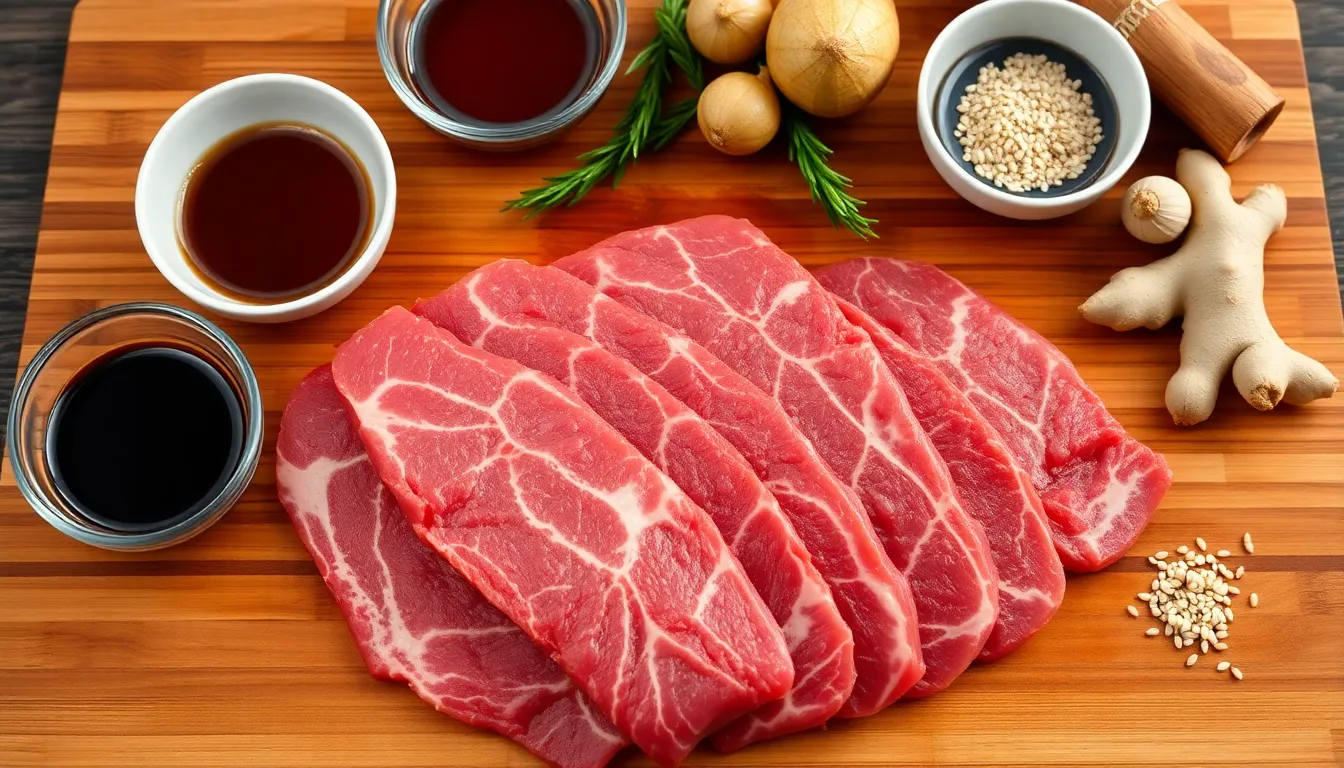
Creating exceptional teriyaki beef jerky requires carefully selected ingredients that work together to deliver authentic Japanese flavors. We’ve curated this precise ingredient list to ensure your homemade jerky achieves the perfect balance of sweet and savory taste.
For the Beef
- 2 lbs top round beef, sliced thinly (¼ to ⅛ inch thick slices)
- Optional: 1 tablespoon sesame oil for added flavor
For the Teriyaki Marinade
- ½ cup soy sauce (or gluten-free tamari)
- ¼ cup light brown sugar
- ¼ cup pineapple juice
- 1 garlic clove, minced
- ¼ teaspoon fresh ginger, finely chopped
- 1 tablespoon sesame seeds (optional)
Teriyaki Marinade Preparation
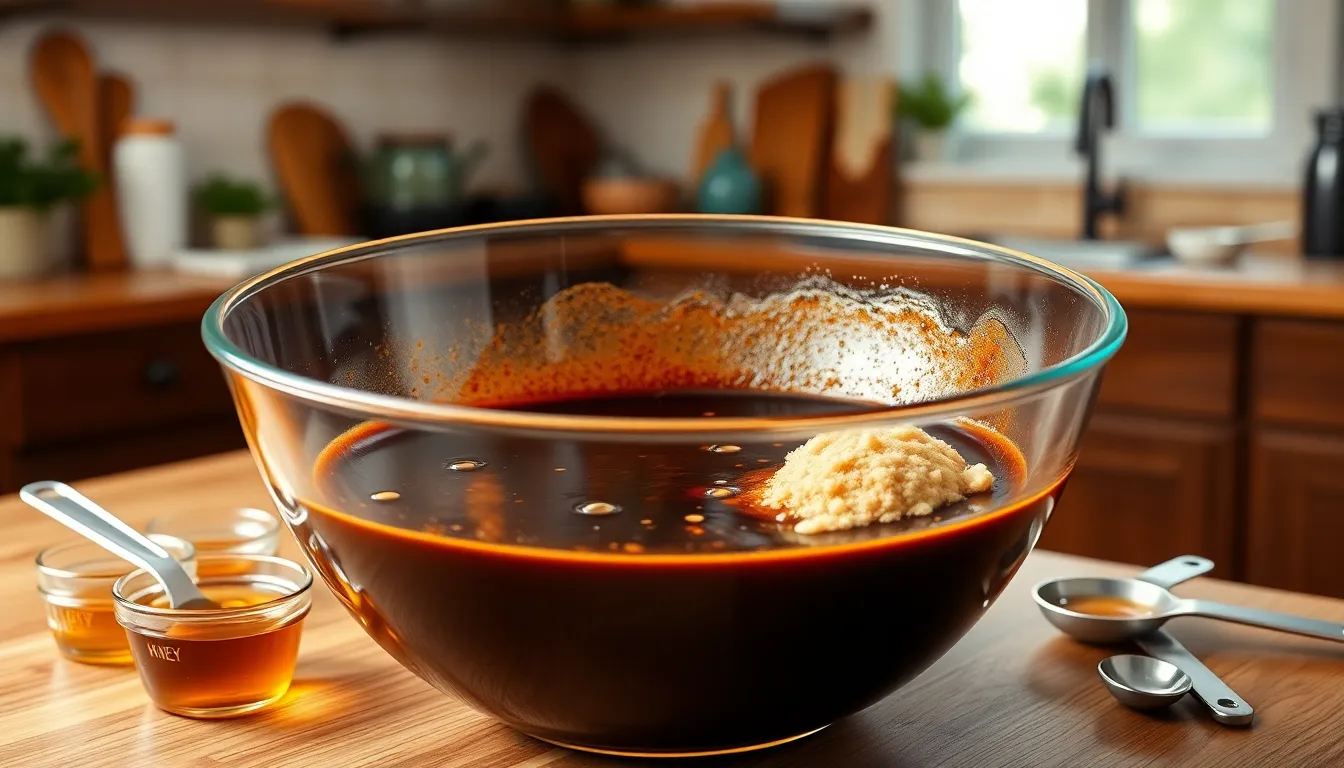
Creating the perfect teriyaki marinade sets the foundation for exceptional beef jerky that balances sweet and savory flavors. We start by gathering all our marinade ingredients in one convenient location to ensure smooth preparation.
Combine the Base Ingredients: In a large mixing bowl we whisk together ½ cup soy sauce and ¼ cup water until fully combined. The water helps distribute the marinade evenly while preventing the sauce from becoming too thick during the marinating process.
Add Sweeteners and Aromatics: We gradually incorporate ¼ cup brown sugar into our soy sauce mixture while whisking continuously to prevent clumping. Next we add 2 tablespoons honey which provides natural sweetness and helps create that signature teriyaki glaze. The minced garlic and ginger get stirred in last to preserve their potent flavors.
Incorporate Final Flavor Elements: A tablespoon of sesame oil gets drizzled into our marinade mixture while we whisk vigorously to create a smooth emulsion. This oil adds authentic Asian flavor notes and helps tenderize the beef during marination.
Marinate the Beef Strips: We place our prepared beef strips into a large ziplock bag or shallow glass dish before pouring the complete marinade over the meat. Every strip needs complete coverage so we massage the bag gently or use tongs to ensure even distribution.
Refrigerate for Optimal Flavor: Our marinated beef goes into the refrigerator for a minimum of 4 hours though overnight marination produces superior results. The extended marinating time allows the teriyaki flavors to penetrate deep into the meat fibers while the natural enzymes begin their tenderizing work.
Prepare for Dehydration: Before transferring to our dehydrator we remove each beef strip from the marinade and allow excess liquid to drip off completely. This step prevents pooling on the dehydrator trays and ensures even drying throughout the jerky making process.
Meat Preparation
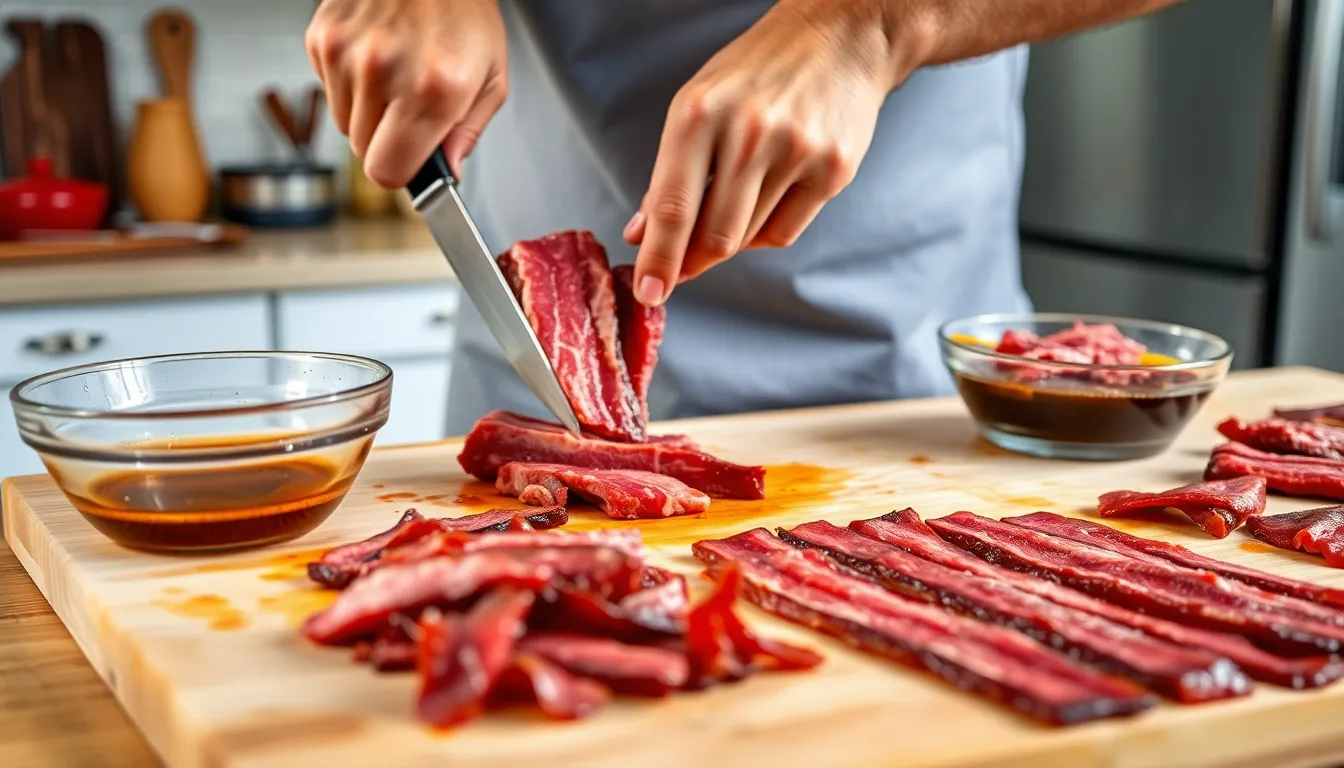
Proper meat preparation forms the foundation of exceptional teriyaki beef jerky. We’ll transform our selected beef cuts into perfectly uniform strips ready for the marinating process.
Slicing the Beef
We begin by placing our beef in the freezer for approximately 30 minutes to firm up the meat before slicing. This crucial step makes cutting uniform strips significantly easier and prevents the knife from tearing through the muscle fibers.
Our sharp knife becomes essential as we slice the beef into thin strips measuring about ⅛ inch thick. We always cut across the grain rather than with it to reduce the final jerky’s chewiness and create a more tender texture. The muscle fibers run in visible lines through the meat and we position our knife perpendicular to these lines.
Each strip should measure roughly 6 to 8 inches in length for optimal dehydrator tray placement. We maintain consistent thickness throughout all strips to ensure even drying during the dehydration process. Uniform pieces prevent some strips from over-drying while others remain too moist.
We trim any remaining visible fat or connective tissue from each strip since fat doesn’t dehydrate properly and can cause spoilage. Our lean cuts like top round or inside round naturally contain minimal fat but we inspect each piece carefully.
Marinating Process
We combine our teriyaki marinade ingredients in a large non-reactive bowl starting with ½ cup soy sauce as our base. Light brown sugar measuring ¼ cup dissolves completely when we whisk it thoroughly with the soy sauce. Our tablespoon of sesame oil adds richness while ¼ cup of pineapple juice provides natural tenderizing enzymes.
Fresh aromatics elevate our marinade’s complexity as we add 1 minced garlic clove and ¼ teaspoon of finely chopped fresh ginger. These ingredients require thorough mixing to distribute evenly throughout the liquid.
We place our sliced beef strips into a gallon-sized plastic bag or shallow dish ensuring each piece gets completely coated with marinade. The bag method allows us to massage the marinade into the meat more effectively while using less liquid overall.
Our marinating timeline spans 12 to 24 hours in the refrigerator for optimal flavor penetration. Shorter marinating periods of 4 to 6 hours work in a pinch but longer exposure creates deeper flavor development throughout each strip.
We turn or massage the marinating beef every 6 to 8 hours to ensure even flavor distribution. This step prevents some pieces from becoming overly salty while others remain underseasoned.
Before dehydrating we remove each strip from the marinade and gently pat away excess liquid with paper towels. Too much surface moisture extends drying time and can create uneven texture in our finished jerky.
Dehydrator Setup
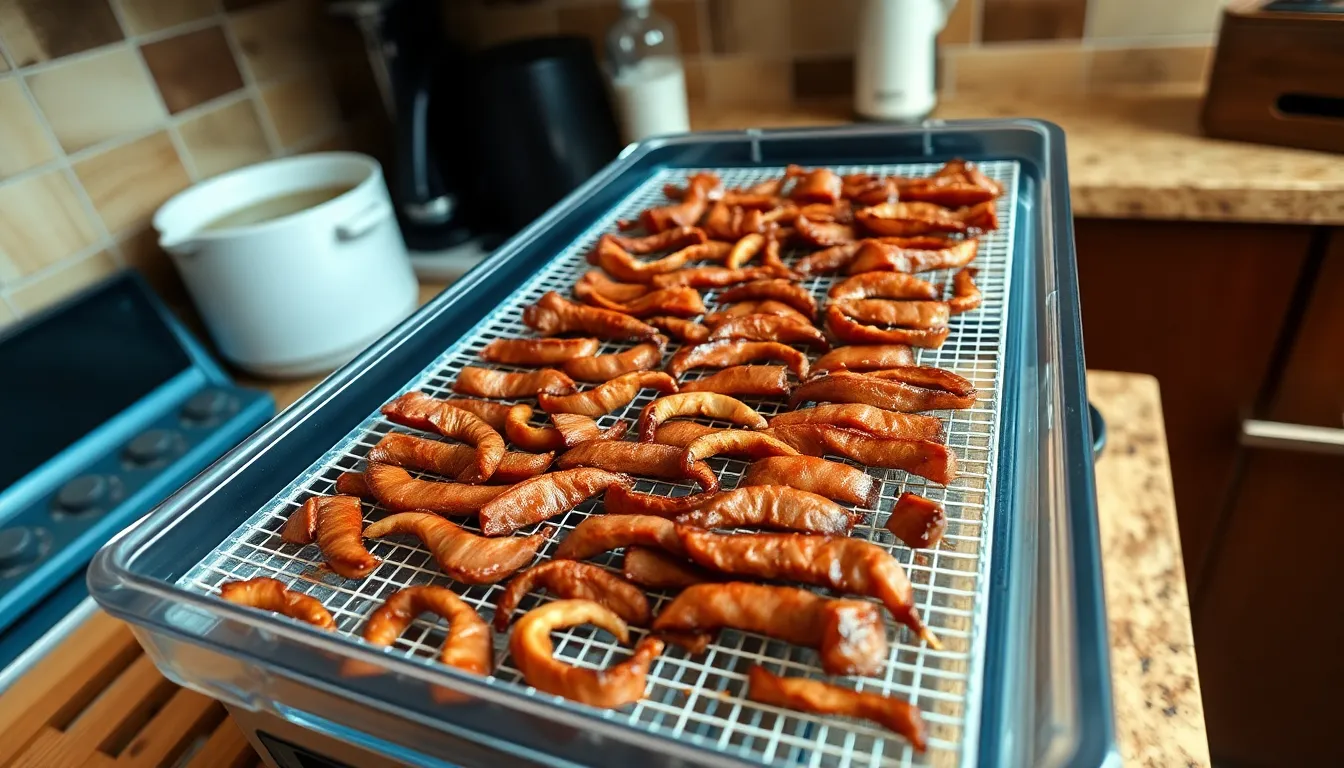
Setting up your dehydrator correctly ensures even drying and safe jerky production. We’ll guide you through the essential temperature and arrangement steps for perfect teriyaki beef jerky.
Temperature Settings
We recommend using a food dehydrator with adjustable temperature control like the popular Excalibur 5 or 9 tray models for optimal jerky making results. Before placing the marinated beef strips in the dehydrator, we must heat them to an internal temperature of 160°F to eliminate harmful bacteria such as Salmonella and E. coli. You can achieve this by briefly heating the strips in an oven or on a stovetop.
Once pre-heated, set your dehydrator temperature to 160°F to 165°F for the actual drying process. This temperature range follows USDA recommendations as the minimum required to kill bacteria in sliced beef. The drying process typically takes 4 to 6 hours depending on your slice thickness and desired moisture content.
| Temperature Guidelines | Purpose | Time |
|---|---|---|
| 160°F pre-heating | Kill bacteria (Salmonella, E. coli) | Brief heating |
| 160°F – 165°F drying | USDA recommended jerky temperature | 4-6 hours |
| 130°F – 140°F alternative | Common after pre-heating | 4-6 hours |
Tray Arrangement
We arrange the teriyaki beef strips in a single layer on each dehydrator tray to ensure proper air circulation and even drying. Never overlap the strips as this prevents uniform drying and creates potential spoilage risks. Each strip should have adequate space around it for optimal airflow.
When using multiple trays for large batches, we rotate the trays every 1 to 2 hours between top and bottom positions. This rotation compensates for slight temperature variations that may occur between different rack levels in your dehydrator. We avoid placing trays too close to heating elements to prevent overcooking certain sections of your jerky.
For consistent results across all trays, we ensure each tray maintains the same spacing pattern and loading density throughout the drying process.
Dehydrating Instructions
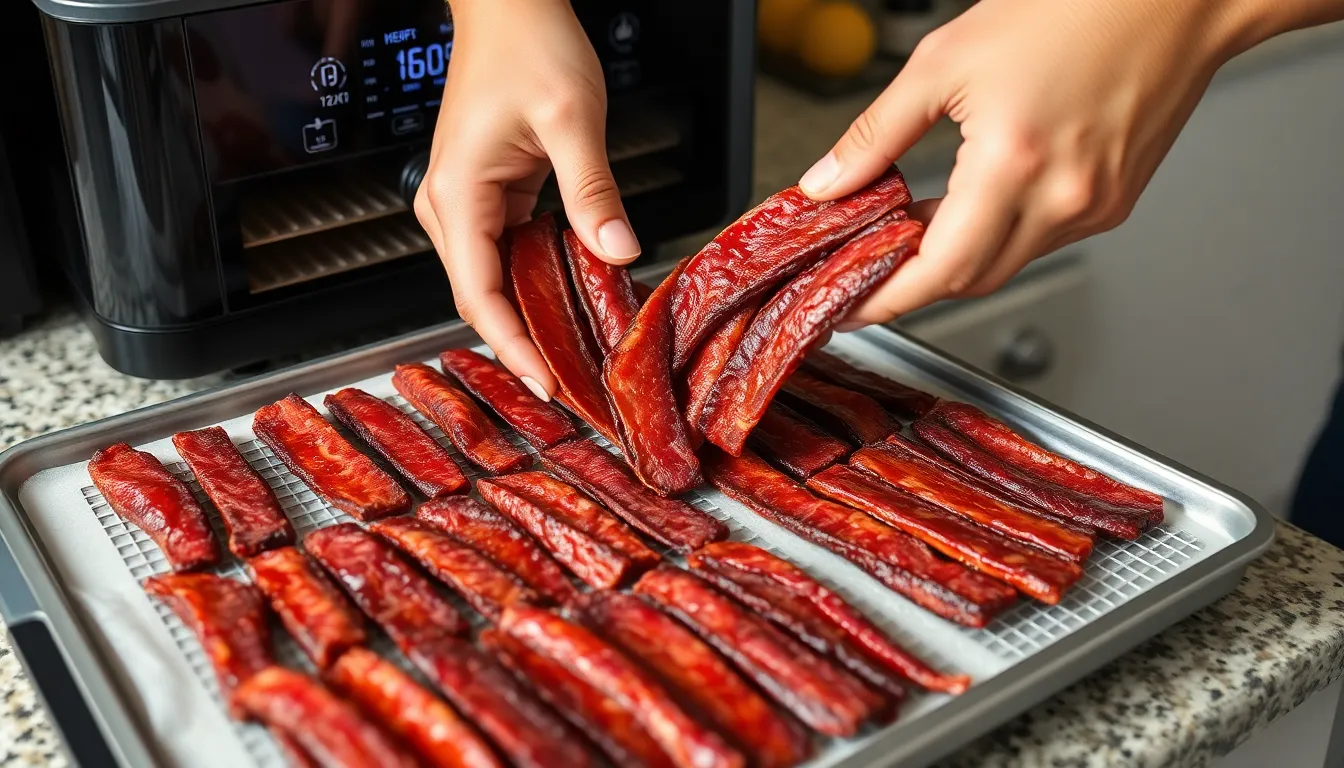
Now that we have our marinated beef strips ready and our dehydrator preheated, we begin the crucial drying process that transforms our tender meat into flavorful jerky. Following the proper dehydrating phases ensures food safety while achieving that perfect chewy texture we desire.
Initial Drying Phase
We start by draining our beef strips from the marinade and lightly patting them dry with paper towels to remove excess liquid without over-drying the surface. Our strips should be arranged in a single layer on dehydrator trays with adequate space between each piece to allow proper airflow circulation.
Setting our dehydrator temperature to 160°F–165°F creates the optimal initial drying environment. We maintain this temperature for approximately 2 hours during the first phase of dehydration. This higher temperature range helps eliminate any remaining harmful bacteria while beginning the moisture removal process.
Checking for Doneness
After the initial 2-hour drying period, we test our jerky by removing a sample piece and allowing it to cool for about 5 minutes. The cooled strip should bend and crack slightly when flexed but not snap completely in half. This indicates our jerky has reached the proper dryness level while maintaining its desired pliable texture.
If our jerky feels too moist or bends without any cracking, we continue the drying process. The beef should feel dry to the touch but still retain some flexibility when properly dehydrated.
Final Drying Stage
We reduce our dehydrator temperature to approximately 145°F for the final drying phase. This lower temperature allows us to complete the moisture removal process without over-drying our jerky. The final stage typically requires an additional 2-4 hours of drying time.
Our total dehydrating time ranges from 4-6 hours depending on the thickness of our beef strips and our dehydrator’s efficiency. The finished jerky should be dry, chewy, and slightly flexible when we remove it from the dehydrator trays.
Storage Instructions
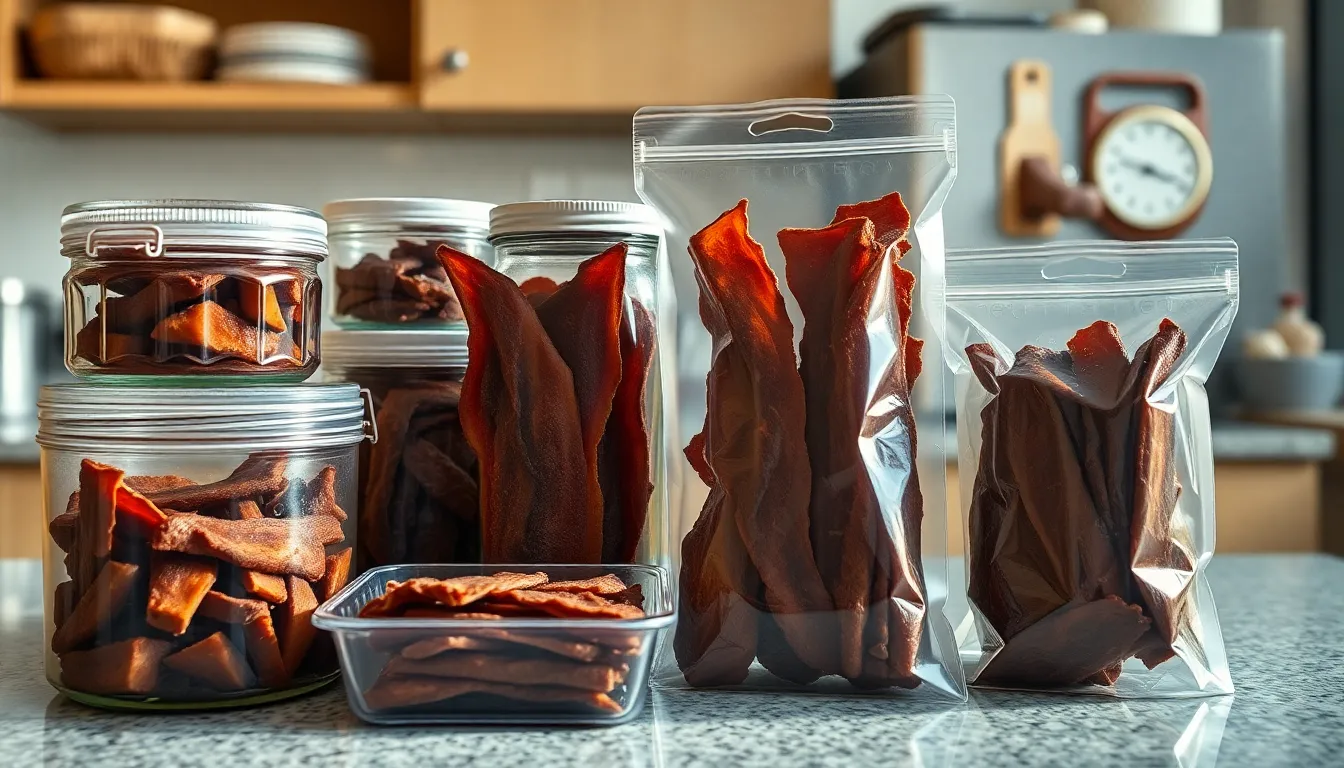
Proper storage techniques will maximize the shelf life of our homemade teriyaki beef jerky and maintain its delicious flavor. Following these guidelines ensures our jerky stays fresh and safe for extended periods.
Proper Packaging
Allow the jerky to cool completely before packaging to prevent moisture buildup that can lead to spoilage. We recommend storing the jerky in airtight containers or vacuum-sealed bags to maintain optimal freshness and prevent exposure to air.
Moisture-absorbing packets such as silica gel provide additional protection for longer shelf life by eliminating any residual humidity. Place the sealed jerky in a cool dry place away from direct sunlight to preserve texture and flavor.
For extended preservation we suggest refrigeration or freezing the packaged jerky. Food-safe storage bags work well for portioning individual servings while maintaining freshness between uses.
Shelf Life Guidelines
| Storage Method | Temperature | Shelf Life |
|---|---|---|
| Room Temperature | Cool, dry place | 1-2 months |
| Refrigerated | 32-40°F | 3-6 months |
| Frozen | 0°F or below | 6-12 months |
Homemade beef jerky stored in airtight containers at room temperature maintains quality for 1 to 2 months when properly dehydrated. Refrigerated jerky extends its lifespan significantly to 3 to 6 months without losing flavor or texture.
Frozen jerky offers the longest preservation period lasting 6 to 12 months without important quality loss. Proper dehydration combined with correct storage methods prevents mold growth and spoilage throughout these timeframes.
These storage guidelines follow food safety best practices to ensure our teriyaki beef jerky remains both safe and delicious over extended periods.
Troubleshooting Tips
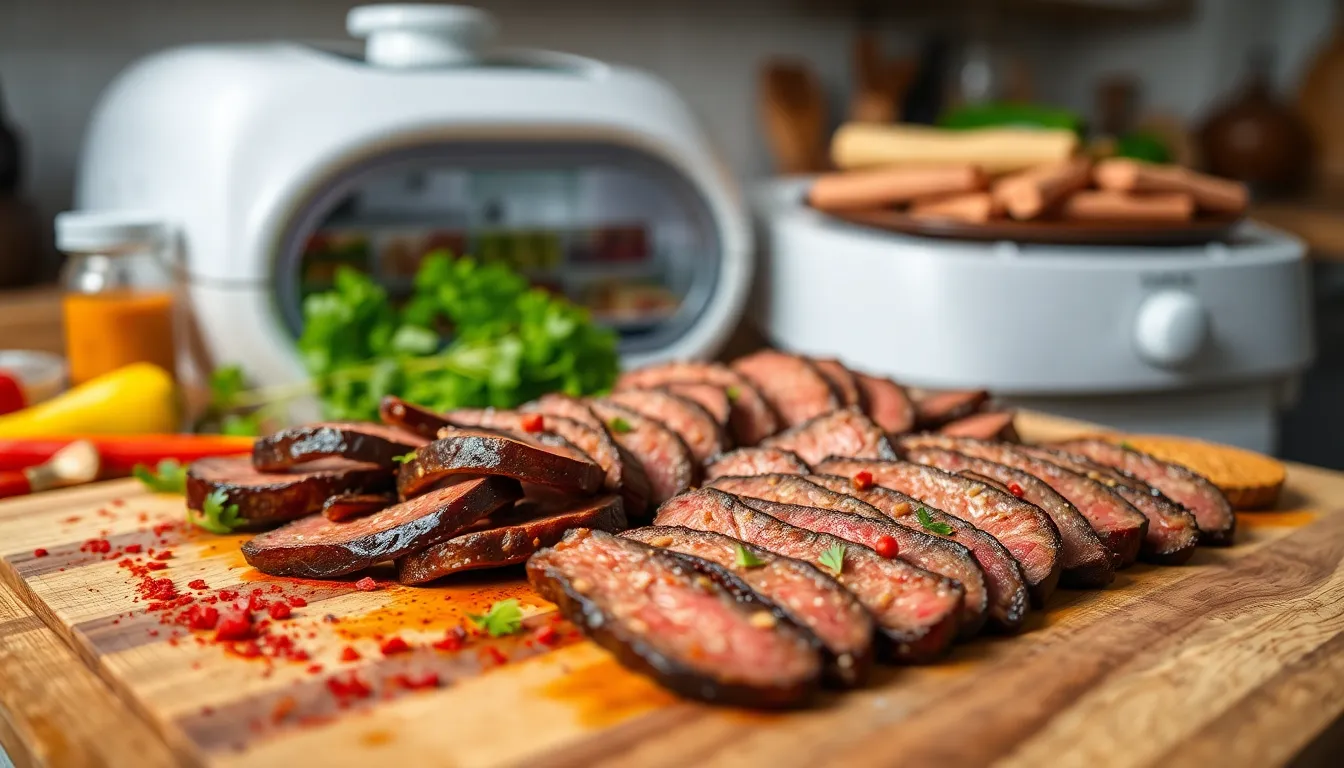
Even experienced jerky makers encounter challenges during the dehydration process. We’ve compiled answers to the most common issues that can affect your teriyaki beef jerky quality and texture.
Common Issues and Answers
Jerky Turns Out Too Dry or Brittle
Over-dehydration creates jerky that snaps rather than bends when cooled. We recommend checking your jerky every hour during the final 2 hours of drying time. The ideal texture allows the jerky to crack slightly when bent but shouldn’t break completely in half. Reduce your dehydrator temperature to 145°F during the final drying phase to prevent excessive moisture loss.
Jerky Remains Too Moist or Won’t Dry Properly
Insufficient air circulation often causes uneven drying throughout your jerky batch. Ensure your dehydrator temperature reaches 160°F to 165°F during the initial drying phase. Check that beef strips aren’t overlapping on the trays and maintain proper spacing between each piece. Rotate your trays every 1 to 2 hours to compensate for temperature variations within the dehydrator.
Jerky Lacks Teriyaki Flavor Intensity
Weak flavor typically results from inadequate marinating time or uneven marinade distribution. We recommend marinating your beef strips for the full 12 to 24-hour period for optimal flavor penetration. Massage the marinade into the meat every few hours during refrigeration to ensure even coverage. Consider adding an extra tablespoon of soy sauce or brown sugar to your marinade for more pronounced teriyaki taste.
White Spots or Mold Appear on Finished Jerky
Fat content in your beef strips can cause spoilage during the dehydration process. Trim all visible fat from your meat before slicing and marinating. Store your finished jerky in airtight containers with moisture-absorbing packets to prevent humidity buildup. Always allow your jerky to cool completely before packaging to avoid condensation inside storage containers.
Jerky Texture Becomes Too Tough or Chewy
Cutting beef strips with the grain rather than against it creates excessively tough jerky. Slice your top round beef across the grain in uniform ¼-inch thick strips for optimal tenderness. Partially freezing your beef for 30 minutes before slicing helps achieve consistent thickness throughout your batch.
Variations and Flavor Modifications
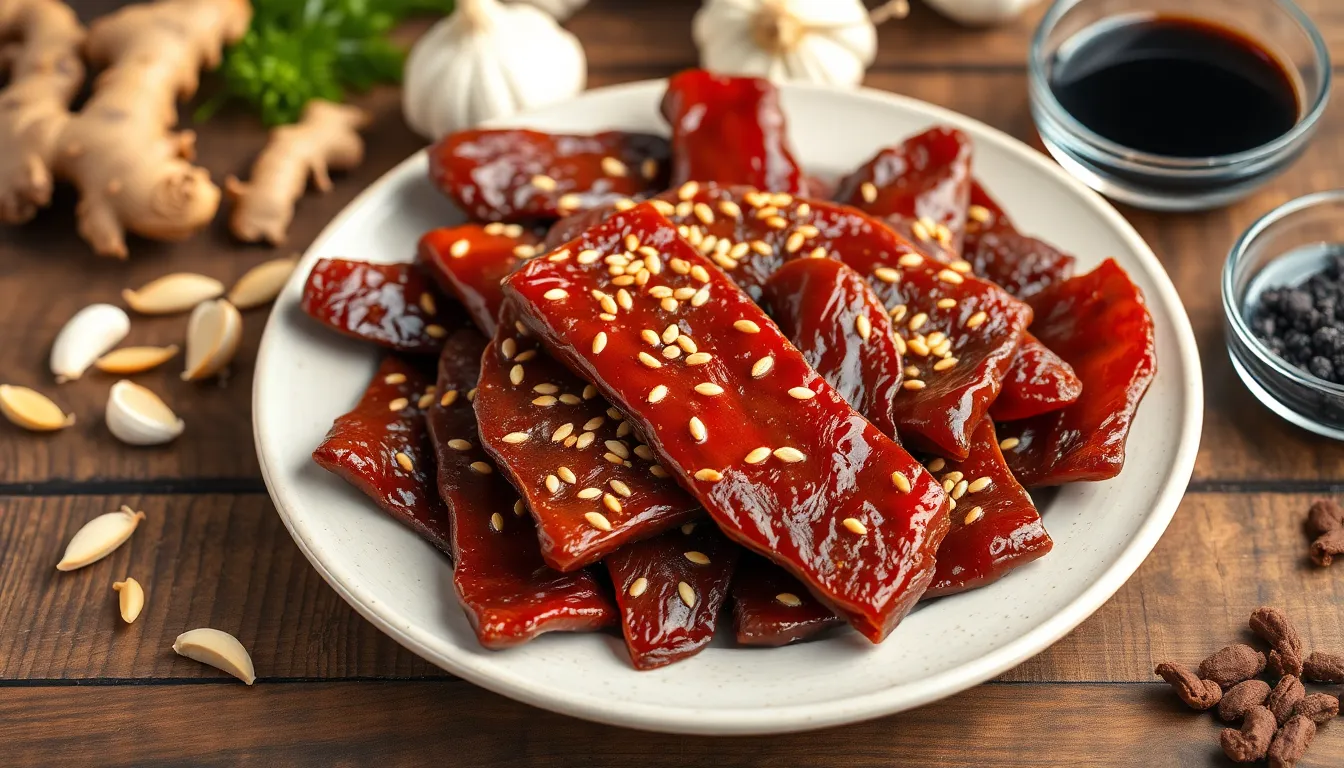
We can transform our basic teriyaki beef jerky recipe into countless delicious variations by adjusting key ingredients and adding complementary flavors. These modifications allow us to customize the jerky to our personal taste preferences while maintaining the authentic teriyaki foundation.
Improving Smokiness Without a Smoker
Adding liquid smoke to our marinade creates depth without overpowering the teriyaki flavor profile. We recommend incorporating 2-3 teaspoons of liquid smoke into our base marinade recipe. This technique delivers that coveted smoky taste while preserving the sweet and savory balance that makes teriyaki jerky so appealing.
Boosting Aromatic Complexity
We can intensify the aromatic qualities of our jerky by cooking certain ingredients in the marinade. Pureeing fresh ginger and garlic during the marinade preparation process releases more essential oils and creates a more complex flavor foundation. Adding white or black pepper to the cooked marinade base further enhances the aromatic complexity without overwhelming the teriyaki essence.
Adjusting Sweetness and Acidity Levels
Our teriyaki marinade becomes more versatile when we modify the brown sugar and rice vinegar ratios. Increasing the brown sugar content creates a sweeter profile perfect for those who prefer dessert-like jerky. Conversely, adding extra rice vinegar or incorporating pineapple juice introduces tropical tang and balances excessive sweetness. This pineapple juice addition also acts as a natural meat tenderizer due to its enzyme content.
Adding Textural Elements
Toasted sesame seeds provide both nutty flavor notes and appealing texture contrast to our jerky. We can add these seeds directly to the marinade or sprinkle them onto the beef strips before dehydrating. The seeds adhere well during the drying process and create satisfying crunch in every bite.
Creating Fusion Variations
| Variation Type | Key Modifications | Flavor Profile |
|---|---|---|
| Spicy Teriyaki | Add sriracha or red pepper flakes | Sweet heat with umami depth |
| Korean-Style | Include gochujang and increase sesame oil | Fermented spice with nuttiness |
| Tropical Twist | Double pineapple juice, add coconut aminos | Bright, fruity with island flair |
| Garlic Lover’s | Triple garlic content, add garlic powder | Bold, savory with teriyaki sweetness |
Professional Enhancement Techniques
We achieve restaurant-quality results by layering flavors throughout the marinating process. Starting with our base ingredients and allowing them to meld for several hours before adding delicate components like sesame oil prevents flavor degradation. This staged approach ensures each element contributes optimally to the final product.
Temperature control during marinating also affects flavor penetration. We keep our marinated beef at consistent refrigeration temperatures between 35°F and 40°F to maintain food safety while allowing gradual flavor absorption. This controlled environment prevents bacterial growth while maximizing marinade effectiveness.
Make-Ahead Instructions
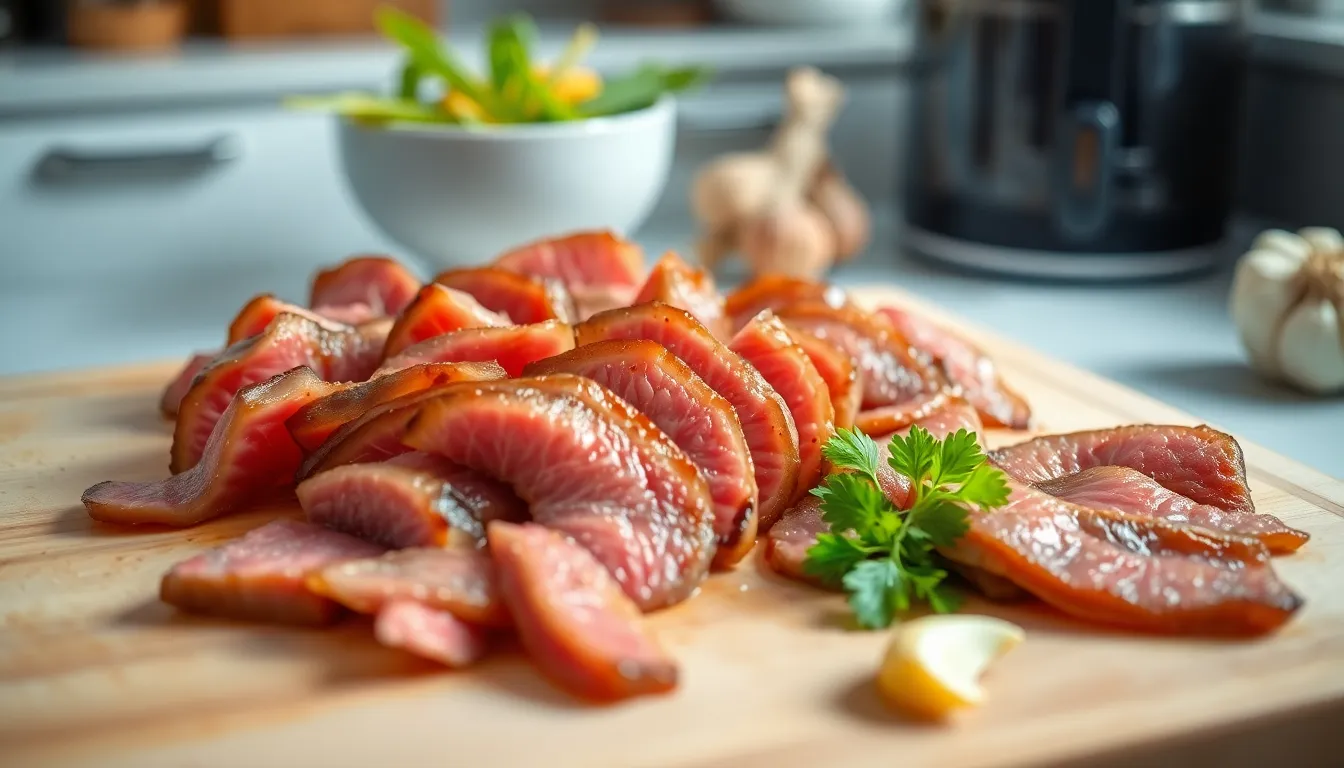
We can prepare every component of this teriyaki beef jerky recipe days in advance to streamline our cooking process. The marinade stores exceptionally well when prepared ahead of time and actually develops deeper flavors during extended storage.
Our marinade can be mixed up to 3 days before we plan to marinate the beef. We combine all ingredients except the meat in an airtight container and store it in the refrigerator. This resting period allows the brown sugar to fully dissolve and the garlic and ginger flavors to meld beautifully with the soy sauce base.
| Make-Ahead Component | Storage Time | Storage Method |
|---|---|---|
| Prepared marinade | Up to 3 days | Refrigerator in airtight container |
| Sliced raw beef | Up to 24 hours | Refrigerator wrapped tightly |
| Marinated beef strips | 12-48 hours | Refrigerator in sealed bag |
| Finished jerky | 1-2 months | Room temperature in airtight container |
| Finished jerky | 3-6 months | Refrigerated in sealed bags |
| Finished jerky | 6-12 months | Frozen in vacuum-sealed bags |
We recommend slicing our beef up to 24 hours before marinating begins. Raw beef strips stay fresh when wrapped tightly in plastic wrap or stored in sealed containers in the refrigerator. This advance preparation saves important time on the day we plan to start the marinating process.
The marinating phase itself becomes our most flexible make-ahead step. We can marinate our beef strips for anywhere from 12 to 48 hours without compromising quality. Extended marinating beyond 24 hours actually intensifies the teriyaki flavors and creates more tender jerky texture.
Batch preparation works exceptionally well with this recipe since we can prepare multiple pounds of beef simultaneously. We portion the marinated beef into separate bags before dehydrating and store unused portions in the freezer for up to 3 months. Frozen marinated beef thaws completely in the refrigerator overnight and maintains its flavor integrity.
Our finished jerky becomes the ultimate make-ahead snack with proper storage techniques. We package completed jerky immediately after cooling in airtight containers or vacuum-sealed bags to preserve freshness. Room temperature storage provides 1 to 2 months of shelf life while refrigeration extends this to 3 to 6 months.
Conclusion
Making homemade teriyaki beef jerky with a dehydrator transforms premium cuts of beef into an irresistible snack that’s far superior to store-bought alternatives. We’ve equipped you with the complete roadmap from selecting the perfect lean cuts to mastering the balance of sweet and savory flavors in your marinade.
The key to success lies in proper preparation – uniform slicing, adequate marinating time, and consistent dehydrator temperature control. With our troubleshooting tips and storage guidelines, you’ll achieve professional-quality results every time.
Whether you stick to our classic recipe or experiment with the flavor variations we’ve shared, you’ll have a versatile skill that impresses family and friends. Your homemade teriyaki beef jerky will be fresher, healthier, and more flavorful than anything you can buy at the store.
Frequently Asked Questions
What cuts of beef work best for teriyaki beef jerky?
The best cuts for teriyaki beef jerky are lean cuts with minimal fat. Top round is the most popular choice due to its affordability and consistent results. Eye of round offers excellent leanness and tenderness, while bottom round provides rich flavor despite being slightly tougher. Sirloin tip, flank steak, and skirt steak are also excellent options for their flavor profiles.
How long should I marinate the beef for teriyaki jerky?
For optimal flavor penetration, marinate the beef strips for 12 to 24 hours in the refrigerator. While a minimum of 4 hours will work, overnight marination is recommended for deeper flavor. Extended marination up to 48 hours will intensify the flavors and improve tenderness, making the jerky more flavorful.
What temperature should I set my dehydrator for beef jerky?
Set your dehydrator to 160°F-165°F for the initial 2 hours to eliminate harmful bacteria and begin moisture removal. After this phase, reduce the temperature to approximately 145°F for the remaining 2-4 hours. This two-stage process ensures food safety while achieving the perfect chewy texture.
How long does it take to dehydrate teriyaki beef jerky?
The total dehydrating time ranges from 4-6 hours, depending on the thickness of your beef strips and your dehydrator’s efficiency. Thicker strips will require more time, while thinner strips dry faster. The jerky is done when it bends and cracks slightly without snapping completely.
How should I store homemade teriyaki beef jerky?
Allow jerky to cool completely before storing in airtight containers or vacuum-sealed bags. Store in a cool, dry place for 1-2 months, refrigerate for 3-6 months, or freeze for 6-12 months. Use moisture-absorbing packets for longer preservation and prevent moisture buildup.
Do I need special equipment to make teriyaki beef jerky?
A dehydrator with at least 6 trays and temperature control (135°F-165°F) is essential for consistent results. You’ll also need a sharp knife for uniform slicing, non-reactive bowls for marinating, measuring cups, food-safe gloves, and paper towels. Look for dehydrators with adjustable temperature controls and horizontal airflow.
Can I prepare the marinade ahead of time?
Yes, the teriyaki marinade can be mixed up to 3 days ahead and stored in the refrigerator, which actually enhances its flavors. Sliced raw beef can be stored for up to 24 hours before marinating. You can also prepare multiple batches and freeze marinated beef for up to 3 months.
Why is my jerky turning out too tough or dry?
Tough jerky usually results from slicing with the grain instead of against it, or over-dehydrating. Cut across the grain to break muscle fibers and reduce chewiness. If jerky becomes too dry or brittle, reduce drying time or lower temperature. Proper marination (12-24 hours) also helps tenderize the meat.
What ingredients do I need for teriyaki beef jerky marinade?
The essential marinade ingredients include ½ cup soy sauce, ¼ cup light brown sugar, ¼ cup pineapple juice, 1 minced garlic clove, ¼ teaspoon fresh ginger, and optional sesame oil and seeds. Use 2 pounds of thinly sliced lean beef like top round for best results.
How do I know when my beef jerky is properly done?
Properly dried jerky should bend and crack slightly without snapping completely in half. It should feel dry to the touch but remain slightly flexible. The jerky should not leave moisture on your fingers when handled and should have a consistent texture throughout each piece.

